Dental implants are artificial teeth that replace your missing teeth. Unlike fillings and crowns which only replace a portion of the tooth, dental implants replace your entire tooth. Considering that dental implants are inserted into the jawbone, it's natural to wonder what materials are used in dental implants. Natural teeth are biological structures made from a hard outer shell, nerve canals, and blood vessels. On the other hand, dental implants are 100% artificial teeth made from three distinct parts: implant post, abutment, and implant crown. Here's a closer look at the material used to fabricate each part of the dental implant:
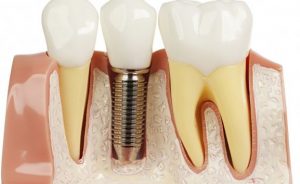
Each dental implant consists of three parts, the implant post, abutment, and implant crown
Implant post material
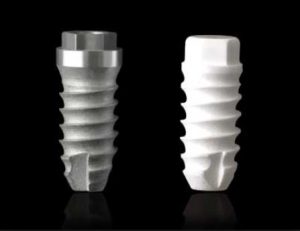
Implant posts are made from either titanium or zirconia
Implant post is the portion of the dental implant that sits inside your jawbone. Most implant posts are made from titanium. More recently, zirconia implant posts have been introduced to the market as well.
Titanium implant post
Titanium alloys are the most common material used to make implant posts. Titanium is sturdy, lightweight, and bio-compatible. Titanium does not cause allergies. It can withstand your bite forces without breaking. This makes titanium an excellent choice for replacing missing teeth. In fact, titanium is also used for hip and knee replacement prostheses, a testament to just how reliable titanium is.
Zirconia implant post
If you're looking for a metal-free tooth replacement option then ceramic implant posts might be right for you. Ceramic implant posts are made from Zirconia Oxide which is metal-free. Ceramic implant posts are hypoallergenic. They are also every bit as durable as their titanium counterpart. If you suffer from an autoimmune condition or have severe metal allergies, then zirconia implants might provide a better alternative to titanium implants for you. Keep in mind that ceramic implant posts are much more expensive than titanium implants. This is because the technology is new and there are only a handful of implant companies that design ceramic implant posts. There are also very, very few dentists who actually offer zirconia implant screws.
Implant abutment material
The implant abutment is the intermediate part that connects the implant post to the implant crown. Abutments are made from many different materials including metals, gold, ceramic, or a combination thereof. The choice of material for abutments is not as critical since your abutment is neither visible nor does it sit inside the jawbone. The vast majority of dental implants are restored using a stock metal-based abutment. If your tooth is in a visible region, like the front teeth, it might not be a bad idea to consider upgrading to a ceramic abutment. Ceramic abutments are made from zirconia, which is white and natural-looking, and a better match to your natural teeth. This is especially useful in the anterior region where your abutment may be slightly visible. Still, you can get similar results using a metal abutment as long as it is properly buried underneath the gum and thus invisible to the naked eye.
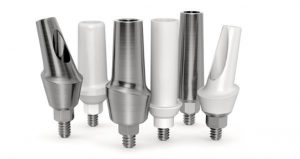
Implant abutments are made from metal or they can be made from ceramic
Implant crown material
The implant crown is the visible portion of the implant that replaces the actual tooth itself. The material used for implant crowns is similar to any other crown that your dentist makes. Gold crowns used to be very popular, but they are pretty much obsolete. Nowadays, most implant crowns are made from either porcelain-fused-to-metal or zirconia.
Porcelain-fused-to-metal implant crown
Porcelain-fused-to-metal crowns, abbreviated as PFM, consist of an inner metal layer and an outer porcelain layer. The metal provides chewing strength, whereas the porcelain provides a natural-looking appearance. PFM crowns work well in most cases, as they are both sturdy and beautiful.
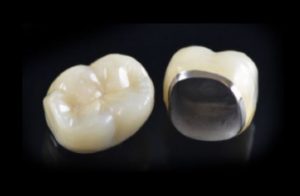
Porcelain-fused-to-metal (PFM) crowns have metal on the inside and porcelain on the outside
Zirconia crown
Ceramic crowns are made from zirconia that resembles tooth structure. Zirconia crowns are quickly becoming the material of choice for most implant restorations. First off, zirconia is stronger than porcelain, meaning that your crown is less likely to fracture under bite pressure. Zirconia crowns are one-piece, and they don't have any metal on the inside the way that PFM crowns do. As a result, zirconia crowns look more realistic than PFM crowns do. Zirconia crowns are the preferred option when there is a heavy bite present. It is also the better choice for patients who suffer from orthodontic issues (such as a crossbite) and are at a higher risk of breaking their crowns. Lastly, zirconia crowns are metal-free, making them the preferred treatment option for those who seek a holistic approach.
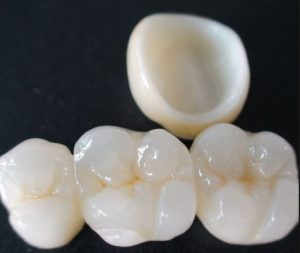
Ceramic crowns are made from zirconia blocks
What is the best material to use for dental implants?
To be honest, when it comes to dental implants, technique and experience are far more important than the implant material. Implant material is a small part of the equation. Obviously, the implant material, thread design, diameter, internal parts, etc. all factor into the final outcome. The difference maker is how well-versed and experienced your implant dentist is. Having said that, the vast majority of patients who get dental implants choose a titanium implant post, a metal abutment, and a zirconia crown. If your tooth is in a very aesthetic region, you might want to consider upgrading to a custom-made zirconia abutment. If you are 100% holistic, then you might want to invest in a ceramic post as well. Although keep in mind that ceramic implant posts are very expensive. Plus, you would have to look for a dentist who offers this type of treatment, and very few do.
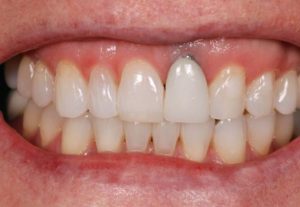
Upgrading to a ceramic abutment and crown may have prevented this from happening
Your dentist will help you determine which type of implant, abutment, and crown is best suited to your needs. There are many factors that affect the final outcome of your treatment. These include your medical history, aesthetic concern, bite forces, allergies, etc. These all need to be taken into consideration when discussing your implant treatment. Work with your dentist to design the perfect implant treatment and hopefully you will be 100% satisfied with the final outcome.
0 Comments